1999 Consumer Electronics Show - Las Vegas
PART 1
This year, the Consumer Electronics Show
in Las Vegas (January 7 - 10, 1999) was definitely focused on
High Definition TV (HDTV), and the pictures were awesome!
One of the reasons it has taken so long, is that TV broadcast
studio conversion is very, very expensive. Panasonic showed their
first HDTV studio TV camera in the United States (photo at left).
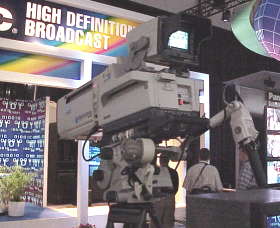 It costs
$120,000, not including the lens. Panasonic had the camera set
up in an actual studio environment and were broadcasting local
programming to monitors in the convention center.
It costs
$120,000, not including the lens. Panasonic had the camera set
up in an actual studio environment and were broadcasting local
programming to monitors in the convention center.
Panasonic also showed numerous DTVs. One must remember that all HDTVs are DTVs, but not all DTVs are HDTVs. DTV (Digital Television) includes formats that are not high resolution, but are still digital. Some of the DTVs that are going onto the market now are 4:3 rather than 16:9. They will receive all DTV broadcasts, including HDTV (HDTV includes 1080i and 720p), but the high resolution signals are downconverted to lower resolutions. If you have a media player installed on your computer, click the next line to download a video (an mpg file) which shows a sample of "Lost in Space" playing on one of the DTVs. [CLICK HERE TO SEE VIDEO OF "Lost in Space" ON DTV] If you don't have a media player, you can find them at Stroud's, including a free one from Microsoft. Regardless of downconversion, the images are superb, and the cost is much less than a full blown HDTV (about $3,000 instead of $7,000). This gives us lots of options in terms of affordable DTVs so that we can watch all the programming.
Sanyo exhibited new 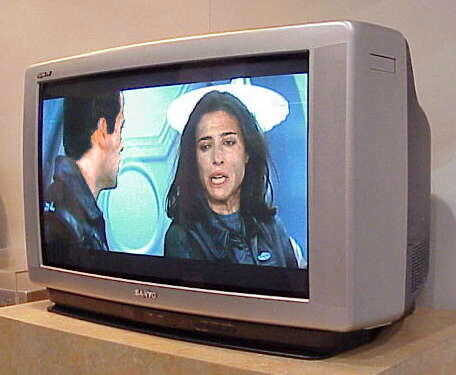 16:9
DTV models, including this 30" one, shown on the right.
It will sell for $3,500, but you have to get the decoder box
for an additional $1,500 if you want to watch HDTV programming.
The unit has built-in line doubling, so that 480i (regular NTSC
material) is upconverted to 480p. The image on the screen is
from "Lost in Space". Local TV stations were broadcasting
HDTV signals over the air in 1080i format and with DD 5.1 surround
sound, for use at the Convention Center. This brings up an interesting
point. I wonder what will happen when broadcasters, such as digital
satellite, are showing movies in HDTV (1080i or 720p, or even
480p), with digital surround sound, and in widescreen format.
The picture will be better than we can get with current DVD,
and the sound will be just as good. Pay per view will cost about
$3.00, and we won't have to go to the video store to get the
movies. Hmmm . . . , this may be a predicament for the DVD manufacturers
and video stores. Maybe they had better get HDTV DVDs into operation
soon. In fact, prototypes (720p) were shown here, so I guess
they are already thinking about this potential problem for movie
rentals.
16:9
DTV models, including this 30" one, shown on the right.
It will sell for $3,500, but you have to get the decoder box
for an additional $1,500 if you want to watch HDTV programming.
The unit has built-in line doubling, so that 480i (regular NTSC
material) is upconverted to 480p. The image on the screen is
from "Lost in Space". Local TV stations were broadcasting
HDTV signals over the air in 1080i format and with DD 5.1 surround
sound, for use at the Convention Center. This brings up an interesting
point. I wonder what will happen when broadcasters, such as digital
satellite, are showing movies in HDTV (1080i or 720p, or even
480p), with digital surround sound, and in widescreen format.
The picture will be better than we can get with current DVD,
and the sound will be just as good. Pay per view will cost about
$3.00, and we won't have to go to the video store to get the
movies. Hmmm . . . , this may be a predicament for the DVD manufacturers
and video stores. Maybe they had better get HDTV DVDs into operation
soon. In fact, prototypes (720p) were shown here, so I guess
they are already thinking about this potential problem for movie
rentals.
All of the major companies were showing
HDTVs. One of the nicest is the Sharp XV-60HDU (photo at left).
It is a rear projection unit, with 3 LCD panels (R,G,B) and 1.3
million pixels. 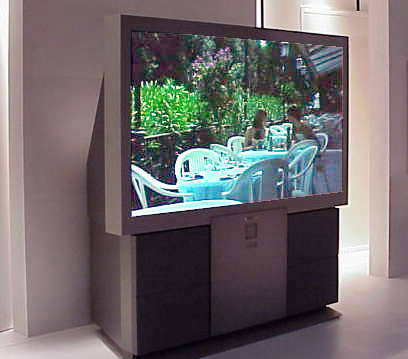 It has a bright,
sharp picture, and will be sold for about $7,000. The overall
appearance of the package is very nice too. LCD TVs are much
better than they were just a couple of years ago. The screen
door effect is gone. Also, the LCD panels last quite a bit longer
than CRTs, so the only thing that has to be replaced now and
then is the projection bulb, a relatively inexpensive item.
It has a bright,
sharp picture, and will be sold for about $7,000. The overall
appearance of the package is very nice too. LCD TVs are much
better than they were just a couple of years ago. The screen
door effect is gone. Also, the LCD panels last quite a bit longer
than CRTs, so the only thing that has to be replaced now and
then is the projection bulb, a relatively inexpensive item.
Plasma screens were everywhere. They are
still very expensive (up to $25,000), and the image quality,
in my opinion, is not as good as direct view or projectors, but
it is a technology that will soon have its day. Notice the example
shown on the right. The plasma screen fits up against the wall
on the mantle above the fireplace. This sort of convenience is
just too good to pass up, and eventually, we will probably all
have this type of screen in our homes. Mass market prices will
be a couple of thousand dollars.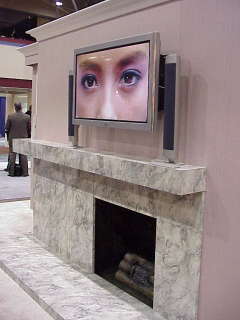
Super audio formats were being demonstrated
in several places. 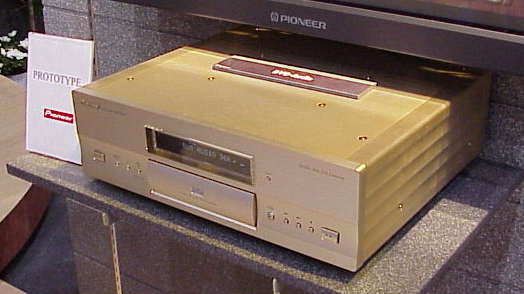 Pioneer
had a prototype player (photo at left). The specs for their DVD
audio format include two channels at 192 kHz - 24 bits, and multi-channel
(as in 5.1) at 96 kHz - 24 bits. The signals are PCM on DVD as
the substrate.
Pioneer
had a prototype player (photo at left). The specs for their DVD
audio format include two channels at 192 kHz - 24 bits, and multi-channel
(as in 5.1) at 96 kHz - 24 bits. The signals are PCM on DVD as
the substrate.
Sony/Philips had their own version of DVD
audio, called Super Audio CD (SACD) which is direct stream digital
(DSD). A prototype player is shown on the right. The players
are estimated to cost about $2,500 once they hit the store shelves.
The SACD discs have two layers, one of which is semi-transparent
(the high density layer), and a deeper layer which is a conventional
CD layer. The discs can be played on conventional players, in
which case, the deeper layer is read. For those consumers who
have the new players, the outer layer is read. Up to 4.7 GB of
data can be stored in this outer layer. The Sony/Philips system
utilizes one bit samples taken at 2.8224 MHz sampling rate. 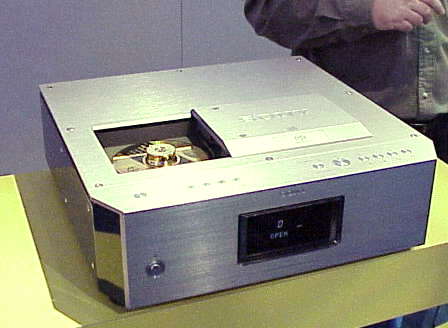 Although this rate approaches 192 kHz - 16
bits in terms of the number of data bits, DSD uses a different
method than conventional 1 bit DACs. With PCM, steep filters
have to be used at the input and output stages in order to keep
signals that are more than twice the sampling frequency (44.1
kHz for conventional CDs) out of the circuit. Otherwise, aliasing
occurs (like in the old Western movies, where the wagon wheels
appeared to be turning backwards). The one-bit technique is called
Pulse Density Modulation (PDM), and the positive portion of waveforms
is represented by 1s, while the negative portion is represented
by 0s. Filters are not required, and the frequency response is
flat from DC to 100 kHz, instead of 20 kHz with conventional
CDs. Although the format is not set up for 5.1 (two channel for
the present), it can probably be adapted for 5.1 use down the
road. Right now, it is for high performance two channel stereo
use.
Although this rate approaches 192 kHz - 16
bits in terms of the number of data bits, DSD uses a different
method than conventional 1 bit DACs. With PCM, steep filters
have to be used at the input and output stages in order to keep
signals that are more than twice the sampling frequency (44.1
kHz for conventional CDs) out of the circuit. Otherwise, aliasing
occurs (like in the old Western movies, where the wagon wheels
appeared to be turning backwards). The one-bit technique is called
Pulse Density Modulation (PDM), and the positive portion of waveforms
is represented by 1s, while the negative portion is represented
by 0s. Filters are not required, and the frequency response is
flat from DC to 100 kHz, instead of 20 kHz with conventional
CDs. Although the format is not set up for 5.1 (two channel for
the present), it can probably be adapted for 5.1 use down the
road. Right now, it is for high performance two channel stereo
use.
The fact that DVD audio can utilize multiple channels (5.1) at 96 kHz and 24 bits leads me to think that we will have this type of sound for our movies before too long. DTS can incorporate it into the current specs, while Dolby Digital will need to modify its specs. DTS and Dolby have done wonders with the compressed audio formats, but 96/24 is so marvelous, it is time to put this capability into operation with our movies. The 96/24 technology is here, and the space on the disc is available, although we might have to use both layers and both sides for each movie. I don't mind this, and I don't think any of you would either. What we want is terrific video and sound. If we have to turn the disc over to get it . . . so what!?
In the audio components arena, Mirage showed
their version of the small box, big sound subwoofer, the SS1500,
which sells for $2,200 (photo at left). 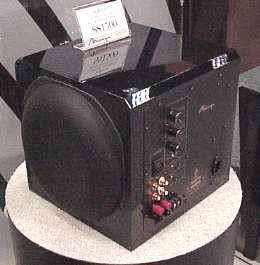 It utilizes
a long throw 10" active driver, with a 10" passive
radiator, and a 1,500 watt digital switching amplifier.
It utilizes
a long throw 10" active driver, with a 10" passive
radiator, and a 1,500 watt digital switching amplifier. 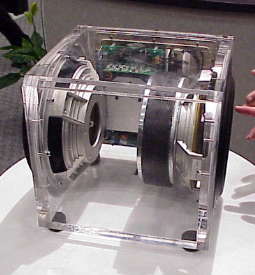 The voice
coil is very large (3" diameter) and the magnet on the driver
weighs 12 pounds. The photo on the right shows the inside of
the SS1500. The active driver is on the right, the passive radiator
on the left, and the amplifier is in the back. Mirage also had
a larger version (12") that was less expensive ($1,100).
The reason is that, due to the larger enclosure, less power is
required, so . . . it is less money. Lots of companies appear
to be designing powerful, yet small, subwoofers. They are hard
to resist, since they fit just about anywhere, and have great
performance.
The voice
coil is very large (3" diameter) and the magnet on the driver
weighs 12 pounds. The photo on the right shows the inside of
the SS1500. The active driver is on the right, the passive radiator
on the left, and the amplifier is in the back. Mirage also had
a larger version (12") that was less expensive ($1,100).
The reason is that, due to the larger enclosure, less power is
required, so . . . it is less money. Lots of companies appear
to be designing powerful, yet small, subwoofers. They are hard
to resist, since they fit just about anywhere, and have great
performance.
CinePro exhibited their new "Predator"
14 channel, 500 watts per channel, power amplifier (photo below
left). 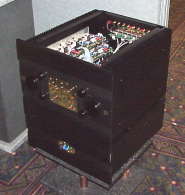 This
unit is designed to work with a Polk Home Theater system of speakers
and represents a very high performance choice for home theater
custom installations. We are talking 7,000 watts of audio amplifier
power here, enough to get 120 dB from those high impact action
films. Of course, you need 240 volt, 50 amp service, so your
house power meter wheel may spin off into space like a frisbee.
One of the features of this package that I really liked was the
fact that each amplifier channel is tailored for the speakers
it is driving. EQ is used so that only those frequency bands
being driven are passed through the amplifier. Thus, its 7,000
watts are utilized very efficiently. Nothing is wasted, even
though the amplifier has plenty to spare.
This
unit is designed to work with a Polk Home Theater system of speakers
and represents a very high performance choice for home theater
custom installations. We are talking 7,000 watts of audio amplifier
power here, enough to get 120 dB from those high impact action
films. Of course, you need 240 volt, 50 amp service, so your
house power meter wheel may spin off into space like a frisbee.
One of the features of this package that I really liked was the
fact that each amplifier channel is tailored for the speakers
it is driving. EQ is used so that only those frequency bands
being driven are passed through the amplifier. Thus, its 7,000
watts are utilized very efficiently. Nothing is wasted, even
though the amplifier has plenty to spare.
Monitor Audio's 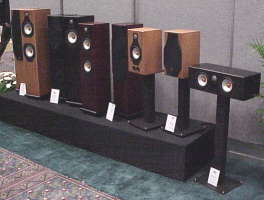 new line
of speakers (photo at right) are quite affordable, yet the finishes
are real wood veneers, instead of wood grained vinyl. They range
in price from $599/pair up to $2,000/pair. Aluminum/magnesium
drivers are used in these speakers, as they are in Monitor's
high performance series, but the magnets are a bit smaller.
new line
of speakers (photo at right) are quite affordable, yet the finishes
are real wood veneers, instead of wood grained vinyl. They range
in price from $599/pair up to $2,000/pair. Aluminum/magnesium
drivers are used in these speakers, as they are in Monitor's
high performance series, but the magnets are a bit smaller.
RBH also showed a new line of affordable,
but wood veneered, speakers. 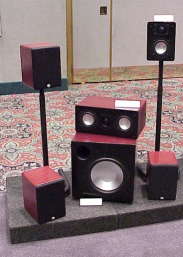 Their
new MC Series, Package 5, has a complete set of surround sound
speakers, and they come in oak and cherry for about $1,600, including
the matching powered subwoofer (photo at left, shown in cherry).
The drivers are all aluminum, including the subwoofer.
Their
new MC Series, Package 5, has a complete set of surround sound
speakers, and they come in oak and cherry for about $1,600, including
the matching powered subwoofer (photo at left, shown in cherry).
The drivers are all aluminum, including the subwoofer.
Exhibitors spend an enormous amount of money (a million dollars) at these shows. All the large corporations have huge booths. So, in order to get your attention, some of them have musicians and dancers. Click here to download a video example.
Five-channel power amplifiers were a big
thing at this year's CES. The high-performance companies like
Proceed showed their new products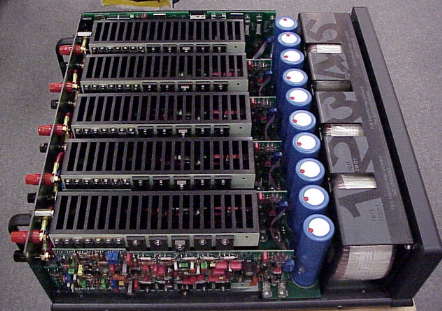 with
the lid off. No wonder too, because the inside of the chassis
is packed with power supply goodies. Notice that, for the Proceed
(photo at right), each channel has its own power supply toroidal
transformer and pair of large power supply capacitors. Like most
five-channel amplifiers these days, it's modular. 125 watts per
channel x 5. Price is $4,995.
with
the lid off. No wonder too, because the inside of the chassis
is packed with power supply goodies. Notice that, for the Proceed
(photo at right), each channel has its own power supply toroidal
transformer and pair of large power supply capacitors. Like most
five-channel amplifiers these days, it's modular. 125 watts per
channel x 5. Price is $4,995.
Pass Labs, 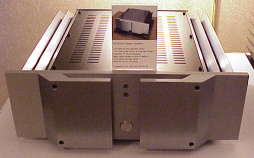 renown
for amplifier quality, jumped into the home theater amplifier
arena with their version of five-channel amplification. It has
125 watts per channel x 5, with only two gain stages (all MOSFET)
in each amplifier (most amplifiers have at least 3). The amplifier
weighs 85 pounds and is elegant, to say the least.
renown
for amplifier quality, jumped into the home theater amplifier
arena with their version of five-channel amplification. It has
125 watts per channel x 5, with only two gain stages (all MOSFET)
in each amplifier (most amplifiers have at least 3). The amplifier
weighs 85 pounds and is elegant, to say the least.
Numerous readers have asked us about CD
juke boxes. Most of the ones we have seen in the past are not
of very high quality. Denon changed all that with the introduction
of their DCM-5000 100 CD Changer. 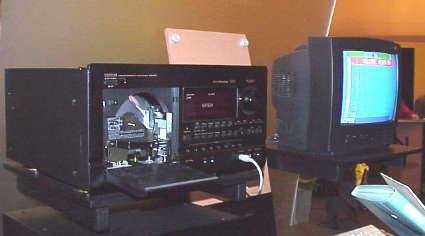 It has
dual transports (so you can begin playing a second CD immediately
after the first one is finished), HDCD decoding, 24 bit DACs,
and on-screen TV menus. The DCM-5000 is $1,800, and will handle
up to five DCM-5001 slaves, each of which will hold 100 CDs.
The slaves are $1,300 each.
It has
dual transports (so you can begin playing a second CD immediately
after the first one is finished), HDCD decoding, 24 bit DACs,
and on-screen TV menus. The DCM-5000 is $1,800, and will handle
up to five DCM-5001 slaves, each of which will hold 100 CDs.
The slaves are $1,300 each.
Marantz showed their new SR-18 Surround
Sound Receiver, which retails for $2,700. 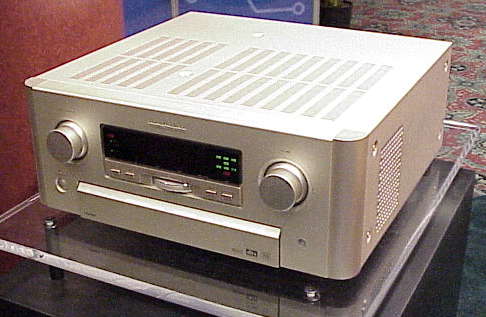 It has five
channels of 140 watt power, THX, and will decode DD and DTS.
It uses a thumb wheel control for FM/AM tuning, like their designs
of decades ago ("Retro" design).
It has five
channels of 140 watt power, THX, and will decode DD and DTS.
It uses a thumb wheel control for FM/AM tuning, like their designs
of decades ago ("Retro" design).
Sunfire unveiled the latest edition to
their line of small high powered subwoofers. This one has a 7"
driver, 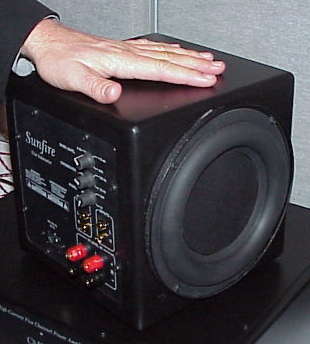 7"
passive radiator, 1,200 watt amplifier, and weighs only 28 pounds,
yet will deliver 105 dB SPL at 22 Hz. Price is $895. This thing
would literally go under your bed in the dormatory! I'll bet
this small powerful subwoofer is a huge success. Great bass in
the <$1,000 range has been hard to find.
7"
passive radiator, 1,200 watt amplifier, and weighs only 28 pounds,
yet will deliver 105 dB SPL at 22 Hz. Price is $895. This thing
would literally go under your bed in the dormatory! I'll bet
this small powerful subwoofer is a huge success. Great bass in
the <$1,000 range has been hard to find.
The new Acoustic Research AR1 Floorstanding Speakers use Sunfire amplifier technology to drive the subwoofers. They have very high sensitivity (95 dB/w/m), and so, would perform nicely with receivers.
M&K showed their 750 THX Select speakers, which are the first speakers to incorporate the THX Select specifications (THX quality performance designed for small rooms).
Krix introduced their 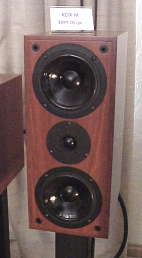 new KDX
speakers (photo at right) which are two-way, with drivers arranged
in the D'Appolito configuration. They sell for $895/pair and
would be a nice set to have in a home theater (four of them,
plus the KDX-C for a center channel). They are finished in Jarrah,
which is an exotic hardwood sourced in Australia, and also used
in South Africa as railroad ties, because it resists the elements
so well. It's very beautiful and looks like a combination of
rosewood and walnut.
new KDX
speakers (photo at right) which are two-way, with drivers arranged
in the D'Appolito configuration. They sell for $895/pair and
would be a nice set to have in a home theater (four of them,
plus the KDX-C for a center channel). They are finished in Jarrah,
which is an exotic hardwood sourced in Australia, and also used
in South Africa as railroad ties, because it resists the elements
so well. It's very beautiful and looks like a combination of
rosewood and walnut.
Lots of new audio and video cables were shown. Nordost, long known for their flatline cables, exhibited a power cord that utilizes the technology developed for Nordost Quattro Fil, and also some new aluminum dampers to be placed under DVD players. Click here to see Joe Reynolds, of Nordost, describe them.
All in all, I enjoyed this year's CES much better than the last one. Apparently others did too, as attendance seemed to be up quite a bit. It seems obvious that we will never again be in a situation where the technology is in a resting phase. There will always be some new digital format or feature on the horizon. I hope that mass market products, like some of the high performance units, will be upgradable by software downloaded from company websites. That is the only way we will be able to stay in touch with this constant change.
J.E. Johnson, Jr.
PART 2
The high end audio industry is alive, well, and recently gathered in Las Vegas, Nevada for the 1999 version of the Consumer Electronics Show, and what a show it was! I've read the editorials and heard the skepticism about the future of two-channel audio reproduction, but if Vegas was an accurate barometer, the industry is positively brimming with talent, enthusiasm, and creativity.
About 90,000 of my closest friends and
I descended on Las Vegas (aka Lost Wages) to see, hear, and feel
the latest in consumer electronics. Of course only a small percentage
of us were there for the sole reason of seeing what's new in
high end audio, but count me among the devoted. I heard that
Las Vegas is the only city with enough hotel rooms to accommodate
this convention, which is believable, but let's face another
reality, the cities where this event can be held in the dead
of winter are pretty limited regardless of the number of hotel
rooms available.
I spent three great days touring the many display rooms at the
"official" specialty audio show held in the Alexis
Park as well as the "outlaw" The Home Entertainment
(T.H.E.) Show at the just-next-door St. Tropez. Before we
get into the report and photos, I must congratulate all those
folks that organized both of the shows I attended -- wonderful
job! The rooms were all well marked and easy to navigate. I had
no trouble finding what I wanted to see. The only real trouble
was finding time to see it all.
What was I looking for at CES '99?
My goal at the CES was to seek out lots of the latest high value audio equipment and accessories, then let you know about it so you can check it all out for yourself after reading about it here at Secrets of Home Theater and High Fidelity. The adjective "high value" can apply to a lot of different gear, including the expensive and inexpensive. My criteria for high value is simple: any audio equipment that appears worthy of my hard-earned cash, judged from a price/performance perspective, will be deemed high value. You will notice a predominance of tube equipment in this report, which is in part from personal bias, and part because that's what I most often review and write about for Secrets.
Regretfully, there was a lot of great equipment
that I didn't have an opportunity to see or hear -- to those
manufacturers not mentioned in this report who worked so hard
to bring, display and play their equipment, I apologize and will
be sure to catch up with you at CES "Y2K". That promise,
however, presumes that everyone's digital playback equipment
doesn't lock up from "the bug" at 12:01 a.m. on January
1, 2000. That would force everyone to use vinyl playback, which
come to think of it, really wouldn't be such a bad thing, now
would it?
What did I find at CES '99?
The Euphonos Audio Group includes Cyrus Brenneman Audio, Edgarhorn,
and Electra-Print Audio (the superb transformer manufacturer
based in Las Vegas who I will also be working with for the upcoming
"Secrets" on-line DIY preamp project). These guys had
two rooms at T.H.E. show, and both exhibits knocked my socks
off. 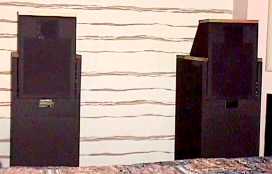 The smaller room
featured the new Edgarhorn Slimline horn speakers at just $1,800/pr
(photo at left). A "Silver Slimline" version is available
for those of you who prefer silver internal wiring (and have
deeper pockets). These attractive speakers measure 51"H
x 14.5"W x 20.5"D, making them visually compatible
with many listening rooms where other horn speaker designs may
not fare so well. The three-way design uses two 5" drivers
in a folded-horn configuration for the bass, which extends down
to 60 Hz (where a nice sub like the Carver True Subwoofer can
take over). Impedance is 8 ohms and get this -- efficiency is
100 dB/w/m! Whoa, Nelly! Get out the flea-powered amps and get
ready to rock. The sound in the room, driven by a Cyrus Brenneman
Stereo 20 amp ($3,995), was incredibly dynamic, articulate, and
realistic. This speaker strikes me as a stunning accomplishment
at the price point and is in need of serious further investigation.
The smaller room
featured the new Edgarhorn Slimline horn speakers at just $1,800/pr
(photo at left). A "Silver Slimline" version is available
for those of you who prefer silver internal wiring (and have
deeper pockets). These attractive speakers measure 51"H
x 14.5"W x 20.5"D, making them visually compatible
with many listening rooms where other horn speaker designs may
not fare so well. The three-way design uses two 5" drivers
in a folded-horn configuration for the bass, which extends down
to 60 Hz (where a nice sub like the Carver True Subwoofer can
take over). Impedance is 8 ohms and get this -- efficiency is
100 dB/w/m! Whoa, Nelly! Get out the flea-powered amps and get
ready to rock. The sound in the room, driven by a Cyrus Brenneman
Stereo 20 amp ($3,995), was incredibly dynamic, articulate, and
realistic. This speaker strikes me as a stunning accomplishment
at the price point and is in need of serious further investigation.
Speaking of Cyrus Brenneman Audio, his meticulously crafted tube
electronics were providing the drive in both of the Euphonos
rooms. 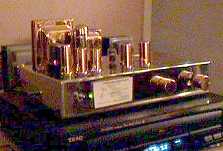 The photo on the right shows the
Cyrus Brenneman Audio Euphonos linestage preamp ($3,500), which
utilizes a host of tubes including the EL-34, 12AX7, 7788, and
12B4A, and features ultra-wide bandwidth and fully regulated
power supplies. A RIAA phono stage can be added to the preamp
for an additional $1,200. It is sitting atop a TEAC CD player.
This combo was being used in the room with the Edgarhorn Slimline.
The photo on the right shows the
Cyrus Brenneman Audio Euphonos linestage preamp ($3,500), which
utilizes a host of tubes including the EL-34, 12AX7, 7788, and
12B4A, and features ultra-wide bandwidth and fully regulated
power supplies. A RIAA phono stage can be added to the preamp
for an additional $1,200. It is sitting atop a TEAC CD player.
This combo was being used in the room with the Edgarhorn Slimline.
In their main room Euphonos was getting some of the best sound
at the show with the Edgarhorn Titan horn speaker system ($19,000
- picture at left). The Seismic Sub ($3,500), which complemented
the Titan with clean bass down to 20 Hz, is designed to go with
the horns. These wonderfully refined speakers were being driven
by the stunning Cyrus Brenneman Silver Reference 20 monoblock
SE amps ($21,500/pr). 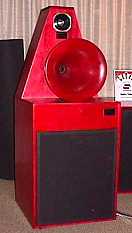 They use 6550
output tubes, custom Electra Print transformers, and have enough
silver in each to start your own mint. Look again at the wild
finish on the Edgarhorn Titans! Not just pretty faces, these
speakers are Bruce Edgar's best effort yet in obtaining truly
musical sound from horns. For large scale dynamics, especially
on orchestral music, this system may be the next best thing to
being there. With 107 dB efficiency available from the Titans,
the Cyrus Brenneman amps were idling along at about 3/4 of a
watt output on even the loudest crescendos! Euphonos truly hit
a home run with these rooms.
They use 6550
output tubes, custom Electra Print transformers, and have enough
silver in each to start your own mint. Look again at the wild
finish on the Edgarhorn Titans! Not just pretty faces, these
speakers are Bruce Edgar's best effort yet in obtaining truly
musical sound from horns. For large scale dynamics, especially
on orchestral music, this system may be the next best thing to
being there. With 107 dB efficiency available from the Titans,
the Cyrus Brenneman amps were idling along at about 3/4 of a
watt output on even the loudest crescendos! Euphonos truly hit
a home run with these rooms.
I spent a lot of time in the room shared by Speaker Art, G&D Transforms, and Placette Audio. Not only great audio designers, the guys that run each of these companies are some of the nicest people you'll meet. The system in this room represented an "all-star" high value package with a lineup of components that each performed beyond typical price range competition. Heading the list was a speaker that I'd read much about, but never heard personally, the Speaker Art Super Clef ($1,795/pr). From what I heard, this speaker deserves every accolade that has been heaped upon it. The full-range sound that this stand-mounted speaker produced was astounding. This was also my first introduction to the Placette Audio Active Line Stage preamp ($3,000) with just about the slickest volume control I've come across -- a 126 step attenuator using all Vishay resistors -- with remote control adjustment! It's difficult to comment on the sound of the preamp, as its goal is ultimate transparency, but the way this system sounded, my only conclusion is that it was successful in its goal. Finally, the G&D Transforms UCD-2 CD player ($2,395) was at the source, providing all the wonderful music I heard. This new design is G&D's realization of a no-compromise, all-in-one CD player. I use their Reference One transport in my own system and can't say enough good things about it.
G&D was also eager to discuss the Maximum Overdrive Break-In Engine (MOBIE), a set of two boxes that significantly speeds analog and digital cable break-in. To really break-in cables, you realistically need a couple months of frequent use, during which time your sound will undergo lots of funky changes. The weird, phasey sound you heard during these months of break-in often result in owner discontent and unnecessary trade-ins/ups. Sure, patience is a virtue in this situation, but how many anxious audiophiles really have the patience to wait that long? The MOBIE will completely break in cables in five days, and you don't have to annoy your family and pets during the process since the MOBIE is a completely self-contained system that makes no noise. Dealers -- are you getting this? I implore you to check into this product. Make your customers happier with their purchase by offering to completely break-in their cables prior to delivery for a modest additional charge (or maybe no charge for the really estoteric and expensive cables). Talk about a win/win situation! At $250, the MOBIE should be a big hit.
Proving that price-point design is doable,
Pathos Acoustics has managed to transfer many of the good ideas
from their well-received Twin Towers integrated amp ($4,950)
into the more affordable Classic One integrated amp ($1,950).
I spent some time listening to this amp with their own Pathos
loudspeaker system ($1,995), which is soon to be released. The
Classic One integrated has a tubed preamplification stage, using
the heretofore unknown to me Ediswan 8625 tube, mated to a solid
state power amplifier stage producing 50 wpc into 8 Ohms, or
95 wpc into 4 Ohms. The soundstage in this listening room was
deep and defined, with treble clarity that was world class. The
deep bass wasn't reproduced as well as I think these speakers
are capable of, but the hotel room acoustics likely had a lot
to do with it. Oh, did I mention that both the Pathos Classic
One and loudspeaker system were flat-out gorgeous? Just as you
would expect from the Italians. I'd like to get to know these
products better in the future -- and speaking of the future,
it sure looks bright for Pathos.
Adjustable speakers? Now why didn't I think of that? Presenting
the Green Mountain Audio Continuum 2 ($5,500/pr in black), possibly
the first fully adjustable speaker that I've run across. 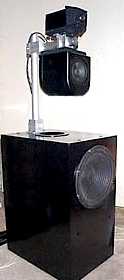 Check out the picture on the right,
and you will see what I mean by adjustable. The alloy tube frame
holding the midrange and tweeter modules can be adjusted in height
and depth -- very cool. The marketing term that Green Mountain
has given this adjustability is "Soundfield Convergence".
I don't know if having the ability to adjust the speaker really
simplifies setup in a given room (tweakers beware - you may drive
yourself silly); however, it does offer tremendous flexibility
to allow the Continuum 2 to interact properly with your own listening
position and your ideal audible phase alignment between the woofer
and midrange/tweeter. You also should see the workmanship on
this whole setup -- impressive. There are a host of other technical
advances incorporated into the Continuum 2 that I won't go into
here, but I would encourage you to seek out more information
to learn about them all.
Check out the picture on the right,
and you will see what I mean by adjustable. The alloy tube frame
holding the midrange and tweeter modules can be adjusted in height
and depth -- very cool. The marketing term that Green Mountain
has given this adjustability is "Soundfield Convergence".
I don't know if having the ability to adjust the speaker really
simplifies setup in a given room (tweakers beware - you may drive
yourself silly); however, it does offer tremendous flexibility
to allow the Continuum 2 to interact properly with your own listening
position and your ideal audible phase alignment between the woofer
and midrange/tweeter. You also should see the workmanship on
this whole setup -- impressive. There are a host of other technical
advances incorporated into the Continuum 2 that I won't go into
here, but I would encourage you to seek out more information
to learn about them all.
None of these technical features matters a hoot if the sound isn't right, of course, so I'm glad to report that the sound was everything you may want, and more. I auditioned the Continuum 2 with vocal music, which was very nice with a deep and clear soundstage, as well as some bass-thumpin', made-for-dancin' music that showcased its significant lower register output capability. I truly enjoy seeing real innovation like that which Green Mountain has put into the design of the Continuum 2 -- a smashing debut for sure.
Audio Note was showing an array of their
new entry level gear aimed at getting those with limited budgets
into the Audio Note sound. A smooth-sounding system consisting
of their P-Zero power amp ($1,199), M-Zero preamp ($599), CDT-Zero
transport ($799), and DAC-Zero converter ($699) was playing an
emotionally involving rendition of Mahler's First Symphony, recorded
in 1951 in glorious mono sound. The sound was not what you typically
think of as "hi-fi", but musically satisfying nonetheless.
I spent a brief but interesting few minutes in the room of Ryan
Research listening to his Model 73 floor-standing speaker system.
This two-way design utilizes a pair of 6.5" carbon fiber
drivers for the mids and highs, complemented by a silk dome tweeter.
The speakers can be bi-wired and have sturdy gold plated 5-way
binding posts. The honey oak finish looked great. Efficiency
is a strong 91 dB, although the impedance is 6 Ohms nominal/
3.75 Ohms minimum, making them a challenging load for some tube
gear. Driven appropriately with excellent solid state gear, I
found the sound cohesive and punchy, with a deep soundstage.
At an MSRP of $1,500/pr., these speakers are value-oriented.
The rest of the Ryan Research lineup consists of a stand mounted
monitor speaker, Model 72, at $800/pr. and a center channel,
Model 73C, at $700 each.
Having read so much about the company in the audio press, I was
anxious to hear the Atma-Sphere Music Systems room where their
renowned amps were driving speakers by Classic Audio Reproductions.
With the Atma-Sphere MA-1, Mk II mono amps ($7,995/pr - 14 6AS7
tubes per channel!) pumping out some serious BTUs, I wasn't sure
what was hotter, the room, or the music they were playing. I
applaud any demonstrator willing to play Depeche Mode and Garbage
(at my request) back-to-back -- on vinyl nonetheless! The front
end was a Sota Star turntable and Atma-Sphere MP-1 Mk II preamp.
The sound emanating from the Project T-1 speakers ($21,600/pr)
was so easy to listen to -- smooth and spacious, yet convincingly
dynamic. The Project T-1 speaker uses TAD drivers and boasts
efficiency of 98 dB. Classic Audio Reproductions offers a whole
host of speaker systems to satisfy all types of low-powered tube
audionuts. This was one of those rooms where you could easily
settle in for a long, long listening session, but alas, onward
I march.
TG Audio Labs teamed up with VMPS for an utterly convincing demonstration of the new VMPS Special Ribbon Edition FF 3 speaker system ($6,800/pr with new larger subwoofer $699) driven by a system that included the CTC Blowtorch preamp ($9,000) hooked to the Plinius 100 Mk III amp ($4,400) on bass and the Bear Labs Symphony No. 1 ($14,000) on the mids and highs. The digital setup included the Entech/TG Number Cruncher DAC (being closed-out direct at $2,200 -- a deal) fed by the G&D Transforms UTP-1 transport ($1,500). Analog sounds were from a Sota/Benz Glider combo with a CTC-modified Vendetta SCP-2T phono stage ($5,000). All the gear had its AC cleansed by the TG BybeeSucker 1 for analog ($1,500) and BybeeSucker 3 for digital ($2,500). The wire was exclusively TG Audio, of course. This system, while not inexpensive, was incredible from top to bottom and garners one of my votes for "Best of Show". For an idea of how it sounded, close your eyes, think about the last live music event you attended, then imagine a similar sonic experience packed into a hotel room at the St. Tropez -- there, you're pretty close to what I heard that day.
A variety of value-oriented gear was being
displayed at T.H.E. Show by Musical Design. Their vacuum tube
based linestage preamp, the SP-4 ($1,495), was paired with the
affordable and excellent D-75B Platinum stereo power amp ($1,995).
On the front end, the new T1 transport ($1,495) using the Pioneer-based
stable platter mechanism, was feeding a DAC-1A Platinum ($2,495)
HDCD-capable decoder. The platinum designation means that the
component has top-of-the-line passive parts such as exotic audiophile
resistors, Blackgate capacitors, special diodes, and more. All
cabling for this good-sounding system was Musical Design's own
Aura line, which are very affordable and well-constructed. Rounding
out the system were speakers from Scientific Fidelity.
A new company based in Singapore, Diva Classic Audio, shared
a room with Champlain Valley Speaker Company, and the combo proved
impressive. T.S. Lim, a musician and designer of the Diva line
of gear, holds simplicity, musicality, and purity among the cornerstones
of his design philosophies. Plus, he's a big fan of vintage NOS
tubes to extract the ultimate performance from his gear, which
is right in line with my way of thinking. The Diva Classic 200
preamp ($1,395), combined with the Diva Blue Sky power amplifier
($1,795), were driving a pair of Champlain Valley Speaker Company
Neutrino 0.5 speakers ($1,800 in Cherrywood) to wondrous effect.
Champlain Valley, like Diva Classic, is a relatively unknown
company, but based on what I heard, they deserve some fans. You
would be amazed at the dynamics I heard coming from this small
speaker. It was hard to believe, really. Stephen Sank, the Champlain
Valley designer, has concluded that top-notch parts are essential
to achieve the sound quality he seeks in his designs. The results
of his theories speak for themselves. Judging by my brief but
impressive demonstration of these products, I'd sure like to
learn more about both of these companies.
One of the most enjoyable hours I've ever spent at a high-end audio show was the time spent at an accessory demonstration in the room hosted by Nordost, the red-hot cable manufacturer. Lately, it seems the release of each successive top-of-the-line product from Nordost means that the pinnacle has been moved one notch higher.
Our demonstration was conducted by Lars Kristensen, the international marketing director for Nordost, and a person that truly believes in the power of allowing one's own ears to be the judge. Accessories are tricky to demonstrate effectively, but this demo was simple -- Lars would play some music, make a change, play more music, make another change, and so forth. The products being demonstrated were the new Pulsar Points de-coupling devices ($100 per set of 4 in aluminum and $500 per set of 4 in titanium) and the El Dorado power cord ($600 per 2M cord). There isn't sufficient space here to re-cap the entire demonstration, but a two-word summary of the product demo would be "they work"! The insertion and removal of both the El Dorado power cord and Pulsar Points (both aluminum and titanium) had a significant effect on the impact, dynamics, depth, and overall "life" of the music during our demonstration. Simply put, with these accessories in the system, even individually, the music had more of the positive characteristics I just mentioned, and without them, the traits seemed to be lessened, sometimes significantly -- with no other system changes.
The demonstration system wasn't elaborate, and the music used wasn't typical "audiophile" fare. In fact, one of Lars' points was that proper accessories can help make even poorly-recorded music more "musical" and enjoyable. His point was hammered home to great effect using a 1968 live recording of Cream's "White Room". I was absolutely jamming to this historic recording, which is average at best, with the Nordost El Dorado and Pulsar Points installed. When removed, the music was harder to get into. No Kidding. I know, I know . . . the true test would be one with single or double blind methods, but I was impressed with this simple demo, nonetheless.
I will be listening to both the El Dorado
and Pulsar Points in my own system soon -- I'll be sure to let
you know how it goes after living with each for a while and experimenting
with them in different locations in my system. Bravo, Nordost!
All product demos should be this well-executed.
Kits are back in fashion, and Antique Sound U.S.A. is right there
to meet the needs of those kit builders who want well-designed,
no-frills tube amps and preamps. The choice is yours to build
it yourself or have ASUSA do it for you. I spent a couple songs
grooving to their K2003 stereo, single-ended amp (left), which
uses one of my favorite output tubes, the sweet-sounding EL-84,
driving a pair of 98 dB efficient Cascade 330HE speakers ($6,499
in oak). The speakers may be a little pricey, but the amp was
ridiculously inexpensive at $499 built, and the combo was making
great music together.
The Galante Audio Buckingham (photo at
left), at $6,500/pr., are an ideal match for low-powered, single-ended
amps. They boast oodles of efficiency (100 dB) and an uncanny
ability to reproduce the ever-important midrange in a lifelike
manner. 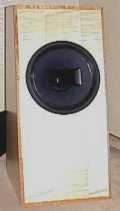 A Cary 2A3 SE Signature tube amp
and SLP-50 preamp were driving the action, with a Sony XA7ES
spinning the silver discs to complete the system. I requested
"I Will Survive" by Cake to find out whether these
speakers could kick out the jams -- and kick they did! To round
out the Galante Audio speaker lineup, they offer the Bedminster
at $4,500/pr. and Silverdale at $2,500/pr. These speakers share
a family resemblance with the Buckingham and a penchant for high
efficiency at 99 dB. This room was a fun time with super sound.
Hail, high efficiency!
A Cary 2A3 SE Signature tube amp
and SLP-50 preamp were driving the action, with a Sony XA7ES
spinning the silver discs to complete the system. I requested
"I Will Survive" by Cake to find out whether these
speakers could kick out the jams -- and kick they did! To round
out the Galante Audio speaker lineup, they offer the Bedminster
at $4,500/pr. and Silverdale at $2,500/pr. These speakers share
a family resemblance with the Buckingham and a penchant for high
efficiency at 99 dB. This room was a fun time with super sound.
Hail, high efficiency!
Attention tube lovers! Israel Bloom, the ambitious and very talented
designer of the Coincident Speaker Technology line, took advantage
of CES '99 to debut a speaker system with YOU in mind.  The new Eclipse, shown on the
right, is a direct descendent of their flagship Millennium loudspeaker,
but it checks in at a price tag of just $3,995/pair, in a gorgeous
Cherrywood veneer. Imagine the wild tube audio thoughts running
through my head when Israel informed me that the Eclipse has
an impedance of 14 Ohms and is 92 dB efficient! (Tube amplifiers
love high impedance, high efficiency speakers.) Frequency response
reaches all the way down to 28 Hz by using dual, side-mounted
8" long-throw woofers. Folks, I heard these speakers driven
by the 18 wpc Manley 300B amps with the new Cal Audio Labs CL-20
CD player at the source, and the sound was stunning. It was more
powerful and dynamic, yet so sweet and open sounding, than it
had any right to be. And get this -- they weren't even fully
broken in yet! A shipping error had delayed their arrival at
CES, and Israel had just set them up a few hours before I arrived.
I must get to know this company because their entire lineup of
speakers are designed to be compatible with low-to-modestly powered
tube equipment (and they do just fine on solid state too, I've
heard). Congrats to Israel on some of the finest sound I heard
at the Show.
The new Eclipse, shown on the
right, is a direct descendent of their flagship Millennium loudspeaker,
but it checks in at a price tag of just $3,995/pair, in a gorgeous
Cherrywood veneer. Imagine the wild tube audio thoughts running
through my head when Israel informed me that the Eclipse has
an impedance of 14 Ohms and is 92 dB efficient! (Tube amplifiers
love high impedance, high efficiency speakers.) Frequency response
reaches all the way down to 28 Hz by using dual, side-mounted
8" long-throw woofers. Folks, I heard these speakers driven
by the 18 wpc Manley 300B amps with the new Cal Audio Labs CL-20
CD player at the source, and the sound was stunning. It was more
powerful and dynamic, yet so sweet and open sounding, than it
had any right to be. And get this -- they weren't even fully
broken in yet! A shipping error had delayed their arrival at
CES, and Israel had just set them up a few hours before I arrived.
I must get to know this company because their entire lineup of
speakers are designed to be compatible with low-to-modestly powered
tube equipment (and they do just fine on solid state too, I've
heard). Congrats to Israel on some of the finest sound I heard
at the Show.
Aren't those little buggers cute? 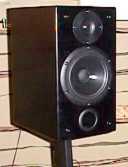 Alon
was showing their new Li'l Rascal mini-monitor speaker system
(shown at left) in a static display. Checking in a $495/pair,
these new speakers could be a major value. The speakers are also
shielded for video use if you choose to use them in a home theater.
Sitting next to the Li'l Rascal was their big brother, the upgraded
Alon I Mk II three-way speaker which is shown below-right without
its front cover. The original Alon I generated a lot of positive
response for its open, natural upper octaves and wonderful imaging.
Alon
was showing their new Li'l Rascal mini-monitor speaker system
(shown at left) in a static display. Checking in a $495/pair,
these new speakers could be a major value. The speakers are also
shielded for video use if you choose to use them in a home theater.
Sitting next to the Li'l Rascal was their big brother, the upgraded
Alon I Mk II three-way speaker which is shown below-right without
its front cover. The original Alon I generated a lot of positive
response for its open, natural upper octaves and wonderful imaging.
 Since the Alon I display was not
in use at the time I visited, I'll be anxious to hear this new
speaker in the future.
Since the Alon I display was not
in use at the time I visited, I'll be anxious to hear this new
speaker in the future.
If you don't know him yet, you will know him soon. Standing proudly
beside his latest offering, named the Grandeur, is Alan Yun (in
the photo on the left), the designer of a great lineup of speakers
from Silverline Audio Technology. Having only recently moved
his speaker manufacturing facility to California from Hong Kong,
Silverline is still establishing itself in the American high-end
audio community. With products like the SR-17, Panatella, SR-12,
and the incredible new Grandeur, word is spreading quickly about
this little company. 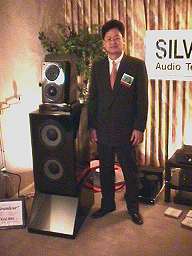 Alan
is truly one of the most engaging personalities in audio, and
his enthusiasm for his products is boundless. I spent a couple
songs listening to the Grandeur, including "Come to Find"
by Doug McCloud, and the sound of these speakers being driven
by the brand new Kron VT 800 amps was shockingly good. No less
impressive, but in a more scaled-down fashion, was the sound
of the budget-priced SR-12 speakers in the second room, shown
in the picture below on the right. Margules Audio was providing
the amplification for this setup, and the performance was very
strong, especially at the price point.
Alan
is truly one of the most engaging personalities in audio, and
his enthusiasm for his products is boundless. I spent a couple
songs listening to the Grandeur, including "Come to Find"
by Doug McCloud, and the sound of these speakers being driven
by the brand new Kron VT 800 amps was shockingly good. No less
impressive, but in a more scaled-down fashion, was the sound
of the budget-priced SR-12 speakers in the second room, shown
in the picture below on the right. Margules Audio was providing
the amplification for this setup, and the performance was very
strong, especially at the price point. 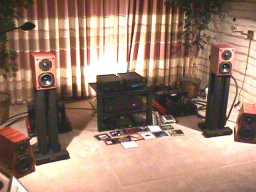 The
Silverline SR-17s are resting on the floor next to the SR-12s,
waiting to strut their stuff.
The
Silverline SR-17s are resting on the floor next to the SR-12s,
waiting to strut their stuff.
Speaking of Margules Audio, their own room
was generating quite a stir among the visitors while we listened
to their U280sc amplifier ($3,280 - picture below left). This
product is amazingly flexible, offering a choice of ultralinear
(60 wpc) or triode (30 wpc) operation, along with the ability
to bridge the amp to mono. Finally, you can also choose among
a variety of output tubes -- 6550, KT88, KT99, or KT100. Have
it your way, as they say about a completely different type of
product. 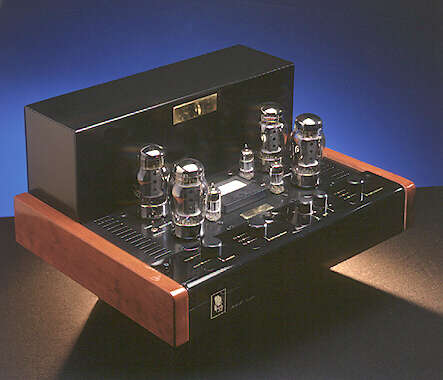 The Margules SF220 ($2,189 without
remote -- other options available) was handling preamplification
duties with aplomb and is good-looking to boot. The speaker was
the model A1.2 ($4,390/pr) which features three drivers in a
two-way design. Extensive detail is paid to the damping of resonances
within the cabinets of these speakers, minimizing the colorations
that can result. There was a smoothness to the sound in the Margules
room that was intoxicating -- bravo!
The Margules SF220 ($2,189 without
remote -- other options available) was handling preamplification
duties with aplomb and is good-looking to boot. The speaker was
the model A1.2 ($4,390/pr) which features three drivers in a
two-way design. Extensive detail is paid to the damping of resonances
within the cabinets of these speakers, minimizing the colorations
that can result. There was a smoothness to the sound in the Margules
room that was intoxicating -- bravo!
I knew right when I walked into the Wavelength Audio room that
real "music" people been at work on these products.
Janis Ian's "Breaking Silence" was spinning in the
CD player, and I simply sunk into the sweet spot for a while
to listen. The Wavelength Triton Signature monoblock amps ($10,000/pair)
were putting 300Bs to good use on the Belle Voce Signature speakers
($8,200/pair), all connected with Nirvana S-X series cable. The
Wavelength Sine 2.5 preamp, together with the digital combo of
the CAL CL-20 transport feeding the Wavelength WA Cosine 24/96
DAC rounded out this wonderful system. This was also my first
opportunity to meet J. Gordon Rankin, the Wavelength guru himself,
who is to be congratulated for an exciting new joint venture
with Western Electric. Gordon will begin making tube amplifiers
with them in the near future. Congrats to Gordon on that and
thank you for the room -- one of the most musical, non-fatiguing,
and enjoyable demonstration rooms I had the pleasure of hearing.
After a particularly excessive lunch I
was wandering back toward the demo rooms, in somewhat of a food-stuffed
daze, when I heard the sweet and familiar sound of Diana Krall
singing "Boulevard of Broken Dreams" from one of the
rooms. That was all I needed to direct me quickly inward. I unfortunately
didn't find Ms. Krall standing there singing, but a tall, attractive
(like Diana) pair of speakers that were doing a great job creating
the aural illusion. These new speakers, pictured on the left,
are from Vince Christian Ltd. and are called the AXIS ($4,000/pair).
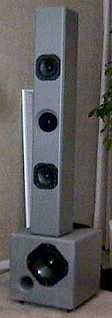 The AXIS was sitting atop the
BASS CUBES ($2,400/pr), which supplement the bass of the AXIS,
but are not required. Should you choose that combo, there is
a specially designed active crossover ($1,700) to optimize the
connection. The electronics in this room were from Birdland Audio
and included the Pleyal 250 mk-II prototype amplifier ($3,850)
which employs Solid-Tube technology, featuring the accuracy of
solid state and the warmth of tubes (description taken from their
brochure). The DAC was the Odeon-m2 24/96 converter that retails
for $3,500.
The AXIS was sitting atop the
BASS CUBES ($2,400/pr), which supplement the bass of the AXIS,
but are not required. Should you choose that combo, there is
a specially designed active crossover ($1,700) to optimize the
connection. The electronics in this room were from Birdland Audio
and included the Pleyal 250 mk-II prototype amplifier ($3,850)
which employs Solid-Tube technology, featuring the accuracy of
solid state and the warmth of tubes (description taken from their
brochure). The DAC was the Odeon-m2 24/96 converter that retails
for $3,500.
If you are into tubes, have a real-world
budget, and appreciate well-designed and great-sounding gear,
please get acquainted with Jolida. The beautiful JD-801A integrated
amp shown on the right, at $1,400, produces 70 wpc out of a quartet
of 6550s, enough to drive just about anything. This amp looked
amazingly well built. Digital gear has made massive leaps forward
since its introduction in 1982, but the logical marriage of tube
output stages within integrated CD playback systems has been
relatively absent from the high-end market over the years, save
for a few designs by CAL and a couple others. 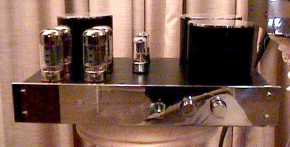 Here
in 1999, on the eve of a new digital playback standard, Jolida
is stepping forward to introduce the JD 602A CD player ($525)
that has a pair of the ubiquitous 12AX7 tubes glowing secretly
within. Inclusion of tubes in the output stage reportedly results
in sound that surpasses most, if not all, of its under-$1K solid
state brethren. I would be curious to hear the JD 602A matched
up against the best digital of even a few years ago -- heck,
just for kicks I'd like to check it out against some of today's
better 44.1/16 digital playback systems. This new giant-killer
from Jolida deserves a full report, and I'll do my best to bring
it to you.
Here
in 1999, on the eve of a new digital playback standard, Jolida
is stepping forward to introduce the JD 602A CD player ($525)
that has a pair of the ubiquitous 12AX7 tubes glowing secretly
within. Inclusion of tubes in the output stage reportedly results
in sound that surpasses most, if not all, of its under-$1K solid
state brethren. I would be curious to hear the JD 602A matched
up against the best digital of even a few years ago -- heck,
just for kicks I'd like to check it out against some of today's
better 44.1/16 digital playback systems. This new giant-killer
from Jolida deserves a full report, and I'll do my best to bring
it to you.
Moth Audio is into beauty -- beauty that can be found in the
appearance and sound of everything they make. The new S2A3 amp
($3,400 normal retail -- introductory priced at $2,700 including
KR Enterprise single-plate 2A3s), shown in the photo on the left,
was on static display, but simply through the choice of the wonderful
2A3 triode, you know that it is going to sound pretty darn good.
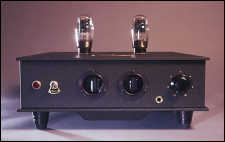 At 3 wpc, you can forget driving
your electrostatics, but if your speakers are very efficient,
the S2A3 amp deserves strong consideration.
At 3 wpc, you can forget driving
your electrostatics, but if your speakers are very efficient,
the S2A3 amp deserves strong consideration.  On active
display, and sounding very good, were the Moth Audio speakers
(photo at right), which I believe are still in the developmental
stages. Judging by the sound, they are well on their way!
On active
display, and sounding very good, were the Moth Audio speakers
(photo at right), which I believe are still in the developmental
stages. Judging by the sound, they are well on their way!
I guess I'll use up my final "Best of Show" vote on
the Silvaweld Audio, Koche, and Pure Silver Connection room.
The Silvaweld SWA-20M ($7,000/pr) monoblock amps deliver 10 wpc
of single-ended 300B triode bliss. The preamp was the SWC-1000R
($6,000), which is transformer coupled and even has 300Bs as
voltage regulators! Wow! This preamp/amp pairing was driving
the impressive Kochel horn speakers ($9,995/pair) with 97 dB
sensitivity. The orchestral music demonstrated with this combo
was effortless in its dynamic contrasts and full of vivid, lifelike
detail and musical nuance. I think I literally sat there for
three straight songs with my mouth slightly agape, speechless
(now THAT was surprising). The interconnects and speaker cables
from Pure Silver Connection were the models PST 8 and R50 single
bi-wire, respectively, which were certainly doing nothing wrong
(and likely a lot right) in this astute company. Silvaweld has
other impressive amplifiers that are more affordable, such as
the SWA-20S stereo 300B amp at $3,000 and the SWC-550 preamp
at $3,000. The importer of all this fine gear is TMH Audio, and
they have an entire lineup of winners with this collection of
brands.
I thoroughly enjoyed the people and products that I was introduced to at '99 CES. We came away with lots of ideas for great equipment that I want to review ASAP. Stay tuned for our reports throughout the year.
Paul Knutson
� Copyright 1999 Secrets of Home Theater & High Fidelity
Return to Table of Contents for this Issue

